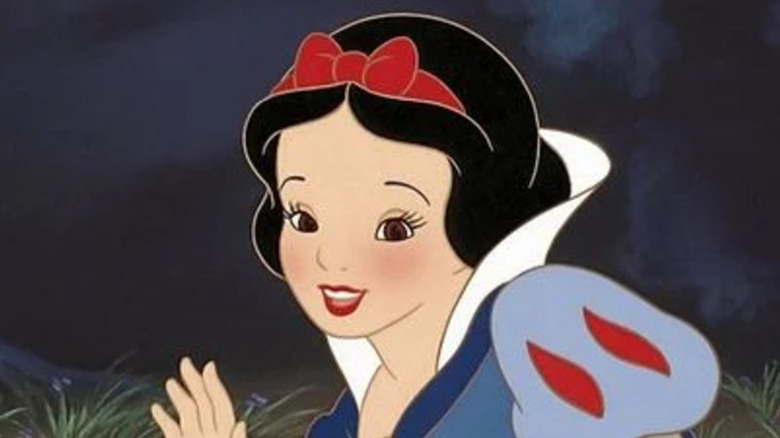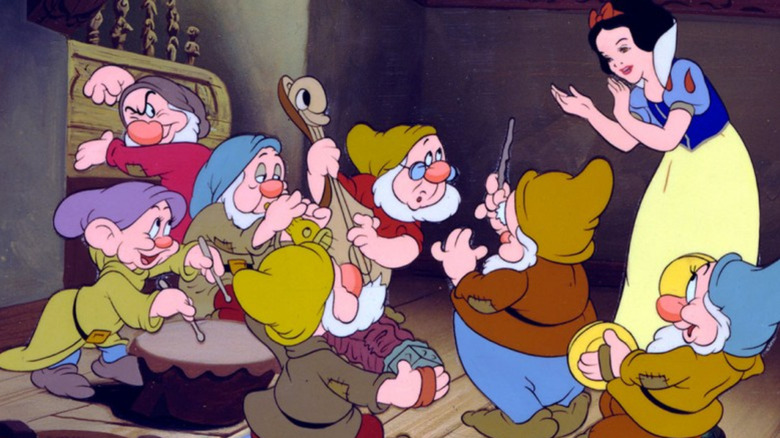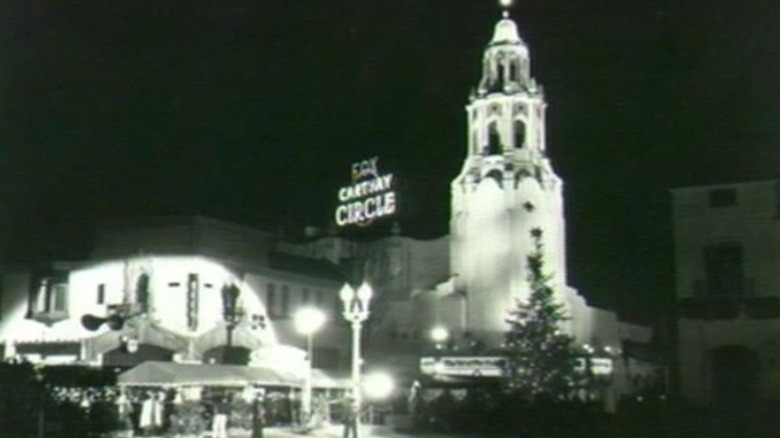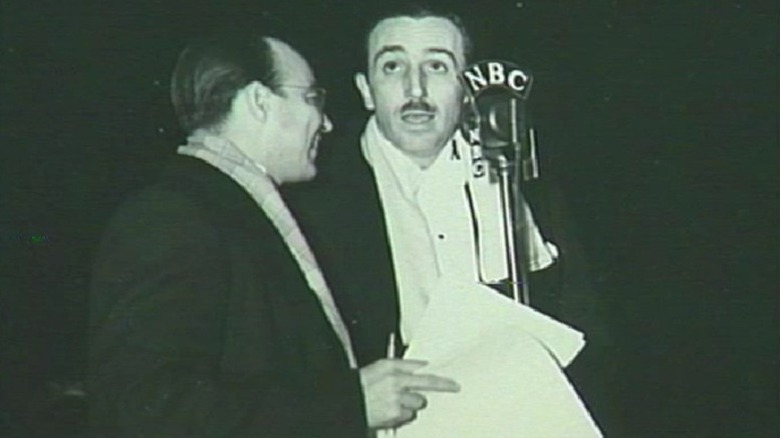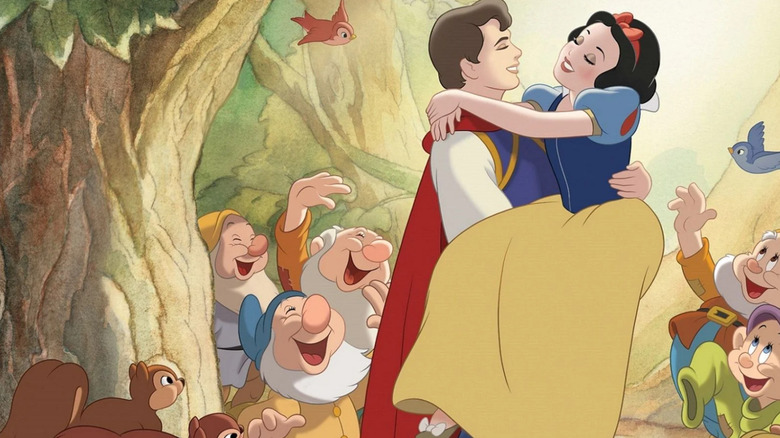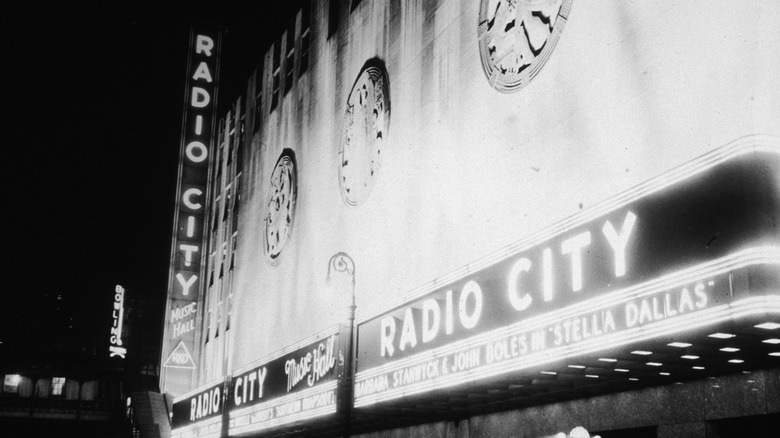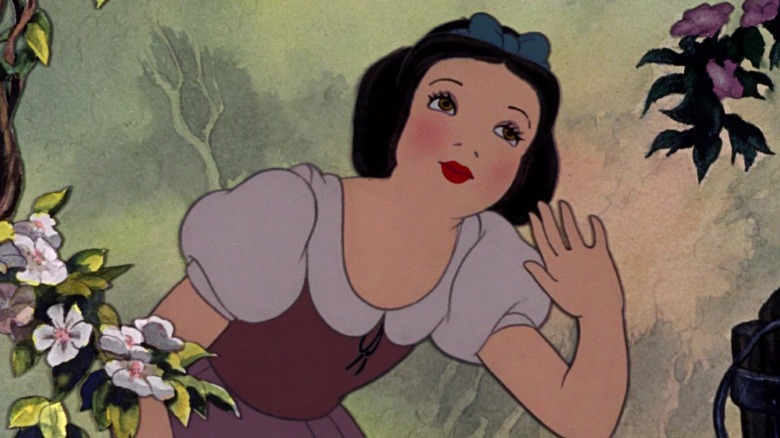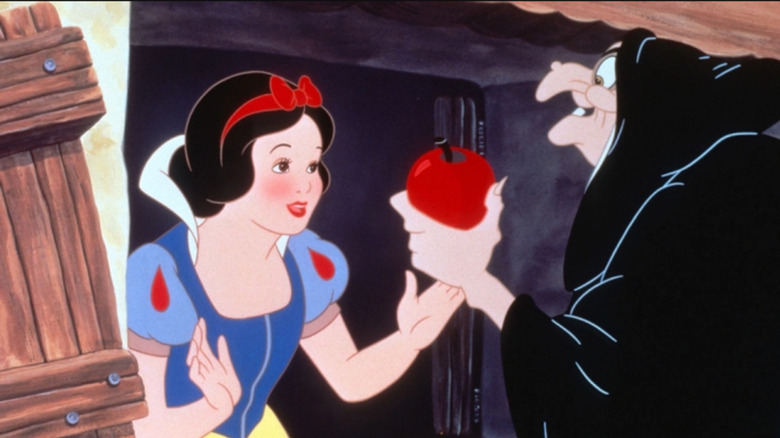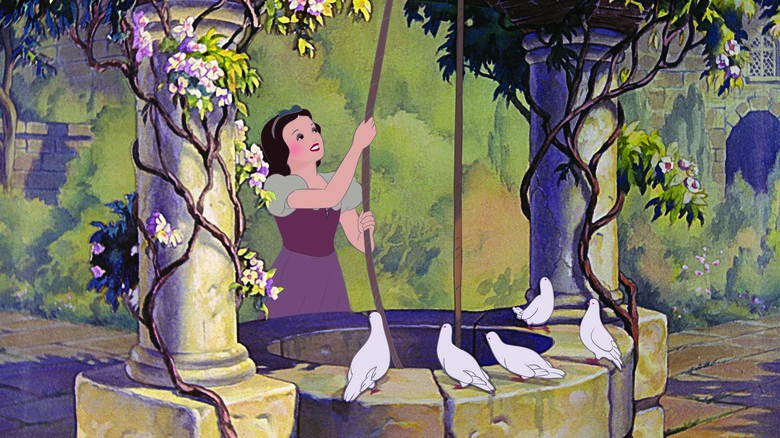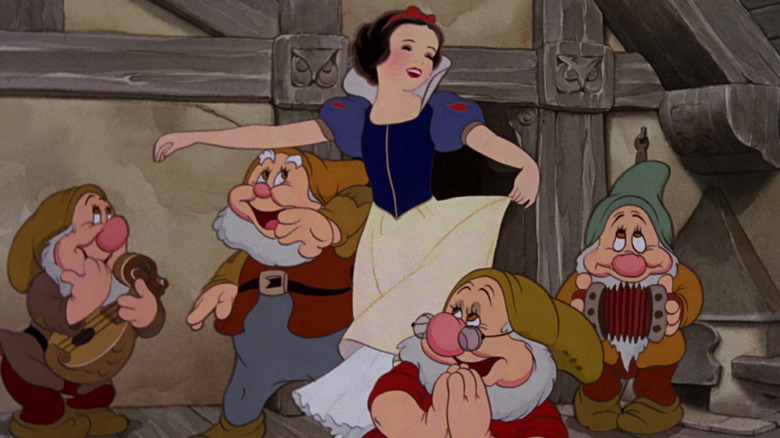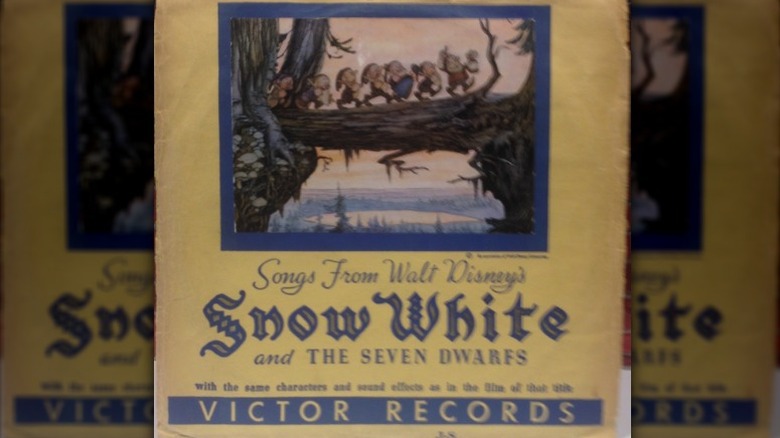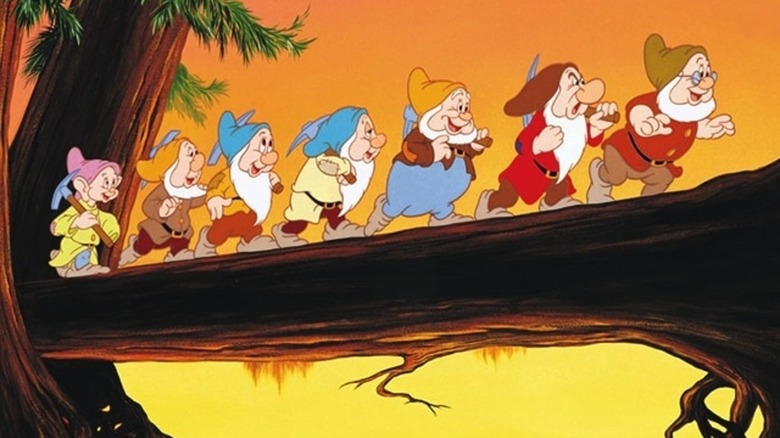What It Was Really Like To See Snow White In 1938
Days before Christmas in 1937, "Snow White and the Seven Dwarfs" premiered to a star-studded, packed audience at the Carthay Circle Theatre in Los Angeles. It was the moment Walt Disney and his cast of animators and voice actors had been waiting for. Disney's first feature film was a big risk for the studio but became a big reward.
The story was inspired by the Grimm fairytale of Snow White but with plenty of changes to make it more palatable and family friendly. The teenage Snow White is "the fairest one of all," a magic mirror tells the Wicked Queen, who is Snow's stepmother. When Snow escapes the palace, she befriends a slew of forest creatures and a family of dwarfs — Sleepy, Dopey, Doc, Sneezy, Grumpy, Bashful, and Happy. In the end, Snow is saved from death by poison apple by a handsome prince and true love's first kiss — which was soon to be a trademark Disney motif.
Disney spent about $1.5 million to make the movie (via History) — putting his and the studio's future on the line by borrowing most of those funds. But "Snow White" was a success from that first night in Los Angeles and subsequent wide-release in February 1938. Audiences and critics loved it, noting both its entertaining and heartfelt story and its historic use of animation and Technicolor.
Here's what it was like to see "Snow White and the Seven Dwarfs" when it premiered.
The premiere included more than a film screening
Hours before the 8:45 p.m. screening time on December 21, 1937, crowds gathered outside the Carthay Circle Theatre to eagerly await the premiere of "Snow White and the Seven Dwarfs" and to be a part of the festivities that came with it.
As J.B. Kaufman's book, "The Fairest One of All," details (via the Walt Disney Family Museum), Disney animation art displays had been set up for fans outside the theater, who were also treated to meet and greets with Mickey and Minnie Mouse and Donald Duck. Seven people were also hired to play the dwarfs from "Dwarfland" while donning masks created by sculpture artist Ted Wiedhaus. There was also a special radio broadcast with announcers from the NBC Blue Network chatting with fans and celebrities as they walked the special blue carpet in front of the theater. Walt Disney and "Snow White" director Dave Hand also provided commentary over the radio, and Disney was reportedly so excited that he forgot the names of the dwarfs.
According to the Walt Disney Family Museum, Snow White herself, Adriana Caselotti and the prince, Harry Stockwell, sang some of their tunes from the film alongside a live orchestra, teasing the film that was about to premiere.
More than 30,000 fans gathered outside the theater
The premiere of "Snow White and the Seven Dwarfs" came at the height of the Golden Age of Hollywood cinema even as Americans continued to grapple with the hardships of the Great Depression. J.B. Kaufman's "The Fairest One of All" presented the scene of opening night on December 21, 1937, as a glamorous affair with thousands lining the street and floodlights illuminating the scene in front of the Carthay Circle Theatre in Los Angeles (via the Walt Disney Family Museum).
Alongside celebrities and other special guests were average moviegoers lucky enough to snag a ticket to the sold-out event. Theater operators said demand was so high that the $5 tickets were limited to four per person. And, Carthay Circle manager Ray Ducerne reported to Disney that advance ticket sales for "Snow White" broke the sales record for the theater, according to Disney.
Of course, not everyone in the massive crowd could make it inside. Disney also said more than 30,000 people stuck around outside before, during, and after the screening just to be a part of the important moment in movie history.
'Hollywood royalty' attended the premiere
Even in the midst of the Great Depression, movie premieres were still glamorous, star-studded affairs. The premiere of "Snow White" was no different, with more than a dozen big-name celebrities turning out for the historic Disney film.
Some of the "Hollywood royalty," according J.B. Kaufman's book, "The Fairest One of All," (via the Walt Disney Family Museum), who attended the Hollywood premiere included Shirley Temple, Charlie Chaplin, Marlene Dietrich, Douglas Fairbanks Jr., Helen Vinson, Claudette Colbert, Gail Patrick, Hedy Lamarr, Preston Foster, and more. Kaufman also wrote that Temple and her friends posed with some of the actors hired to appear as the dwarfs, while other celebrities walked the red carpet and spoke to radio broadcasters.
Walt and Lillian Disney were also there, of course, and wire news services reported that Disney "bit his fingernails, waiting for the verdict of the tail-coated and satin-gowned audience." That same report said the celebrity-filled audience loved the movie.
In the biography "Disney's World," author Leonard Mosley wrote that Disney said to the crowd he had "always dreamed that one day I would attend a gala premiere in Hollywood of one of my cartoons" and that their enthusiasm for "Snow White" made him feel like he had truly become a legitimate filmmaker.
The premiere audience gave it a standing ovation
After three years of production and over $1 million spent on the film (an enormous sum back in the Great Depression-era 1930s, and above the original budget), as per Den of Geek, Walt Disney understandably was nervous during the premiere of "Snow White and the Seven Dwarfs." A PBS documentary (via Vanity Fair) on Disney said he was extremely anxious that night because he didn't know how the audience would react to such a film — the first full-length animated movie.
But the day after the screening, the press reported that the audience loved it. The film earned a standing ovation from the audience, according to History.
In the subsequent weeks, as more and more premieres happened leading to the wide release in February 1938, newspapers reported similar reactions among other audiences seeing the film for the first time. The New York Daily News review reported the audience at Radio City Music Hall applauded enthusiastically when the movie ended. And, the review said there were plenty of audible laughs and gasps throughout the screening from the audience that was completely enraptured with the movie.
Critics loved the movie, even after calling it 'Disney's Folly'
Following its Hollywood premiere, "Snow White and the Seven Dwarfs" ran for five weeks in January 1938 at Radio City Music Hall in New York City before getting a general release the following month, notes Newspapers.com. Disney's first full-length animated feature also garnered both audience and critical acclaim for its historic animation technology and its "delightful fantasy," a New York Times critic wrote.
After attending the premiere of "Snow White," actor Charlie Chaplin told the Los Angeles Times (via History) that the movie exceeded his expectations and he loved Dopey in particular. In Variety's review, the critic wrote "so perfect is the illusion, so tender the romance and fantasy, so emotional are certain portions when the acting of the characters strikes a depth comparable to the sincerity of human players, that the film approaches real greateness (sic)." Harrison Reports, a film trade journal based in New York City at the time, said "Snow White" was a movie that all could enjoy.
The rave reviews from critics and audiences were a boon for a stressed out Walt Disney. Because of all the work and time delays with the film, some critics questioned whether "Snow White" would get to the screen on time for its December 1937 Hollywood premiere (via Newspapers.com). Many critics called it "Disney's Folly," Diane Disney Miller told a Saturday Evening Post reporter. And according to the Disney Parks Blogy "Snow White" had taken three years, more than 700 artists, and nearly 2 million drawings and paintings to bring to life.
Audiences didn't know who the actors were at first
In the official program (via Disney Parks Blog) handed out at the premiere of "Snow White and the Seven Dwarfs," there's a note about the identities of the voice actors lending their talents to the film. The program said the actors were recognizable names of stage and screen but weren't being shared because Disney "feels that it would detract from the audiences' acceptance of the voice as a part of a character."
Eventually, the world would know the real voices behind Snow White, the prince, the queen, and all seven of the dwarfs. The girl behind Snow White was Adriana Caselotti, who was 19 when she auditioned and landed the role. In an interview with Animator Magazine to celebrate the film's 50th anniversary, Caselotti said Walt Disney described her voice as having "a lilting quality" that fit perfectly with Snow's personality.
Caselotti also said she and Harry Stockwell, who voiced the part of the prince, snuck into the premiere because the ticket collector at the door didn't recognize them and wouldn't let them in without tickets. Similarly, many of Disney's own staff hadn't yet seen the full film and had to pay $5 to get into the premiere, according to the book, "Snow White and the Seven Dwarfs: New Perspectives on Production, Reception, Legacy."
The movie was just as popular with overseas audiences
With the general release of "Snow White and the Seven Dwarfs" also came the film's release overseas, and it proved just as popular with those international audiences. The movie enjoyed lengthy box office runs in both Sydney, Australia, and in London. According to "Of Mice and Magic," by Leonard Maltin, film distribution company RKO reported that "Snow White" had earned about $8 million in worldwide box office sales in its original run.
An issue of Variety from September 1938 reported that "Snow White" had hit 11 weeks at the box office in Australia. In London, "Snow White" was in its 27th week of its initial run and would play for several more weeks. The brief report also guessed "Snow White" would continue to run in theaters through Christmas.
The film's overseas run had, at the time, passed $500,000 in box office sales, which surpassed the sales at New York City's Radio City Music Hall in five weeks.
Fan were inundated with merch and marketing
"Snow White" was the first of many things for Disney and for the film industry overall, including the first feature-length movie to have themed merchandise for its premiere.
Merchandising wasn't a new thing for Disney at the time. By 1934, more than 600 different items themed after Disney characters and stories were being sold around the world, according to "Snow White and the Seven Dwarfs: New Perspectives on Production, Reception, Legacy." For "Snow White," Disney pulled out all the stops to market the film to all audiences – local and national newspapers boasted ads for "Snow White" dolls and dwarf figurines (The News-Review), seed packets (The Capital Journal), glassware (The Chillicothe Constitution-Tribune), and even women's clothing inspired by the film (The Evening Independent). Other officially licensed merchandises included puzzles, soap, tea sets, postcards, and lunch pails. Avid fans could also buy food items themed for "Snow White," like hams and bacon, and limited edition movie tie-in cereal with games and images on the back of the box.
Moviegoers loved "Snow White" so much that the New York Times (via the Atlantic) reported more than $2 million just in "Snow White" themed toys had been sold in five months in 1938.
And local business certainly got in on the game, maximizing on the film's popularity to promote products and services. Consumers could "Whistle while you work" with a new refrigerator-radio cabinet combo and buy "quality meats" that Prince Charming eats to get his strength (via The Daily Republican"). Snow also lent her name to fur storage and washing machines, and the seven dwarfs accompanied ads for hats, milk brands, and windows (via "The Leader-Post). There were even some stores and business owners who took advantage of the film's popularity to sponsor activities with fans, like a May 1938 call for readers to vote for their favorite dwarf alongside ads for "Snow White" merch and places to buy Mother's Day gifts (via The News-Review).
Some parents and critics thought it was too intense for kids
While "Snow White and the Seven Dwarfs" is a colorful fairytale, there are some scenes in the film that some parents and critics back in 1938 and even today could consider intense for younger children. Specifically, the scene of Snow running from the huntsman and into the haunted forest, which is dark and full of owls, bats, and trees and plants that seem to have eyes and want to snatch her.
The Disney Archives at D23 detail that, at the time, "Snow White" was deemed too scary for youngsters in England and that any child under the age of 16 had to be accompanied by an adult to watch the film in theaters. Back in the United States, "Snow White" was being praised for showcasing some traditional moral values that had a resurgence during the 1930s, according to "With Amusement For All: A History of American Popular Culture Since 1830," by LeRoy Ashby. At the same time, however, Ashby noted that some adults felt children were missing the beauty and lessons of the film and were instead more fascinated with the scary animation and scenes of danger.
According to research and interviews compiled in the Walt Disney biography, "The Animated Man: A Life of Walt Disney," by Michael Barrier, Disney reportedly had a sense of smug satisfaction when hearing some critics say "Snow White" was too intense for kids. In one interview, he said children younger than 7 or 8 shouldn't be going to the movies at all. And, of "Snow White," he said, he "didn't make the picture for children. I made it for adults — for the child that exists in all adults."
Audiences loved the catchy soundtrack
"Snow White" was the first movie to have a commercially available soundtrack, according to the Los Angeles Times. And, that soundtrack was available for purchase before the movie premiered in theaters — "Snow White's" eight musical numbers blasted over the radio airwaves as part of the massive marketing effort for the film.
In a 1987 New York Times article marking the film's 50th anniversary, Disney archivist David Smith said the marketing for "Snow White" was a huge effort at the time. According to "Snow White and the Seven Dwarfs: New Perspectives on Production, Reception, Legacy," a big part of that marketing effort was popularizing the film's music. Commercials and song rotations promoted the movie's impending release, and weeks before its nationwide opening, "Whistle While You Work" became the 16th most popular song on stations in New York, Maryland, and South Carolina. Then, by February 1938, the book said the song moved up to number 2 and added "With a Smile and a Song" and "Someday My Prince Will Come" to the most popular rotations.
The full soundtrack was originally released in January 1938 as a collection of three 78 RPM records from Victor Records.
Viewers saw a fairytale that reflected the cultural and political ideology of the time
Disney's first full-length animated film wasn't just a charming take on the classic Grimm fairytale. "Snow White" audiences were treated to a colorful animated film that was also chock full of metaphors and allegories for the cultural ideology of the time in which they lived – ethics of hard work and nostalgia of traditional values and gender norms that many hoped would bring them out of the Great Depression.
Throughout history, entertainment has been a form of escapism in times of crises while at the same time reflecting the mood and ideology of a certain era. Following the raucousness of the roaring 1920s, the economic depression of the 1930s saw a reversion to traditional "American" norms of conservatism and hard worth ethics (via "Snow White and the Seven Dwarfs: New Perspectives on Production, Reception, Legacy"). Disney productions and "Snow White" in particular were no exception. The seven dwarfs themselves were clear allegories for capitalism and the morality of hard work and frugality.
The book's chapter on "Framing 'Snow White': Preservation, Nostalgia and the American way in the 1930s" by Jane Batkin also showcases the struggles at the time to balance coming modernity and nostalgia for the past. The dwarfs' behavior also reflected the idea of reaffirming traditional gender roles in order to get through hardships — Snow is a necessity to keep the dwarfs' home in clean order while the men march to work and perform hard, manual labor with smiles and a song.
